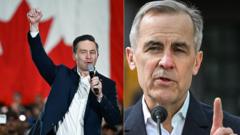In Vaughan, Ontario, tension and enthusiasm marked the final stretches of Canada’s election campaign, with Liberal Leader Mark Carney rallying against US President Trump’s influence. At a recent rally, boos greeted Carney as he claimed, "President Trump is trying to break us." His supporters vocally affirmed unity against external threats, evidenced by waving Canadian flags on ice hockey sticks.
In contrast, Conservative leader Pierre Poilievre attracted large crowds whose primary message echoed "Bring it Home," a sentiment aimed at reclaiming Canadian pride amid US tariff threats. With the election approaching, both parties are focused on asserting which leadership can effectively manage relations with the US executive.
Current national polls offer a mixed picture, showing a tightly contested race. The Conservatives previously held a significant lead, but several unexpected political developments—including Trudeau's resignation—have reversed fortunes. Carney’s rise now puts the Liberals in the spotlight, previously facing suggestions of political obliteration.
Votes expressed by citizens like Eric and Carri Gionet highlight voter anxieties over economic stability and the future of younger generations. The discontent created by soaring housing costs and Canada's sluggish economy has fueled public interest, particularly in Poilievre's promise of change after what he terms a "Lost Liberal decade."
Analysts observe that pressure has shifted back towards the Liberal coalition, now leaning on Carney’s credibility as a seasoned economist as the party aims for a fourth consecutive term. Critics, however, point to a lack of substantial change in policy, questioning the effectiveness of a new face within the same party structure.
The mere shadow of Trump’s presidency continues to be pivotal as voter engagement swells. Political observers note that concerns surrounding his administration's tariffs have driven progressive voters toward Carney’s Liberals. Many see the challenges as a trial by fire for Carney, the first prime minister to enter without prior political office experience.
Contradictory to the Liberal surge, the Conservative outreach message reformulated from "Canada is broken" to a nationalistic "Canada First" indicates an attempt to balance their agenda. Poilievre faces ongoing critiques, facing a narrative branding him as 'Trump-lite' amid rising nationalism in Canadian politics.
While smaller parties like the NDP struggle to gain political traction, they underscore the importance of strategic voting to combat the burgeoning influence of either major party. Both frontrunners are keenly aware of the need to pivot focus to fundamental Canadian issues, including climate, immigration, and indigenous reconciliation, even as the current campaign remains absorbed by economic discourse.
The culmination of this highly contested election may redefine Canada's path, presenting a stark choice between Carney’s experienced leadership amid turbulence and Poilievre's vision for change as voters fundamentally question the future direction for the nation.



















